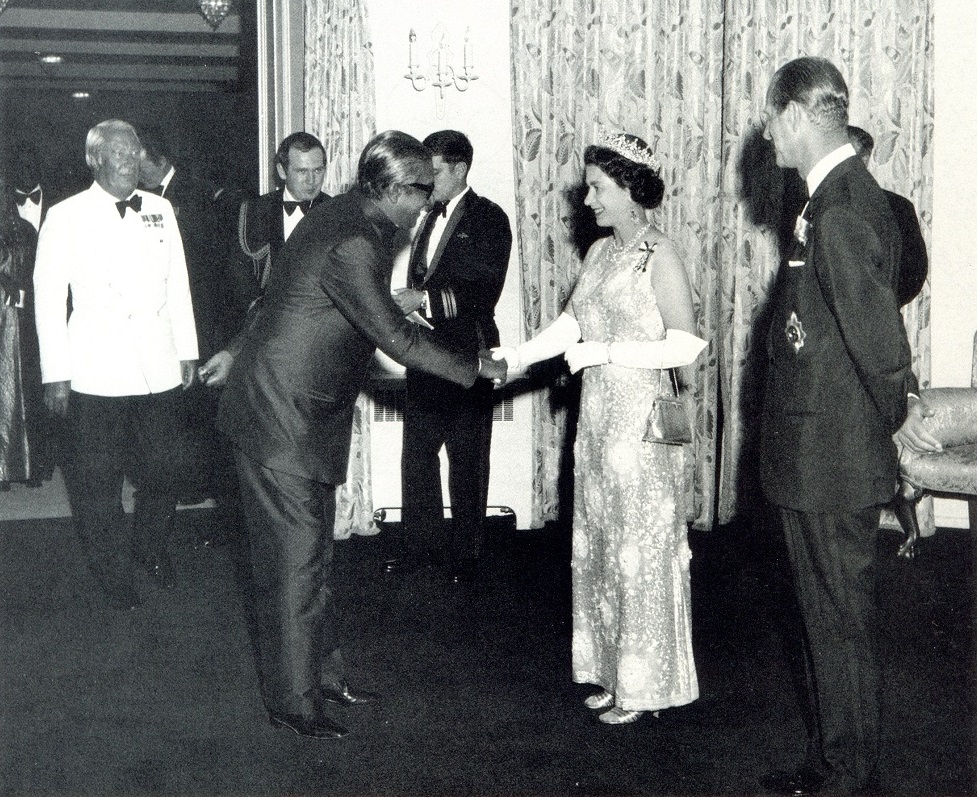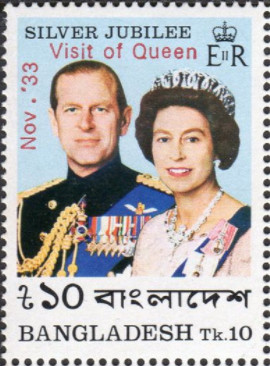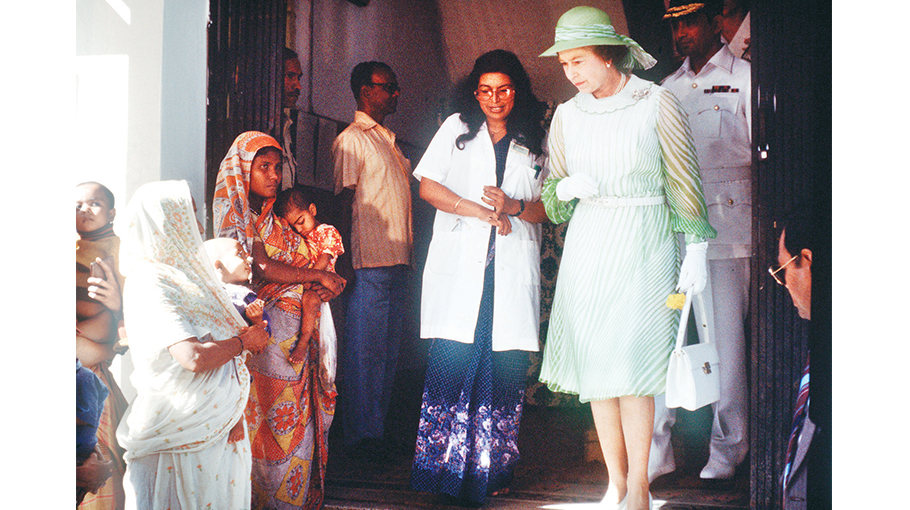Queen Elizabeth II through the years
The British Monarch visited Bangladesh in 1983

In her extraordinary life and reign, British Monarch Queen Elizabeth II also visited Bangladesh in 1983.
During the Royal visit from 14th to 17th November she travelled by train to visit a model village in Chattogram and watched how rice is fried to make what is known as ‘Muri’; handicrafts, including gilded quilts and earthenware.
Colourful posters of the Queen, banners reading 'Long live Bangladesh-United Kingdom friendship' and Union Jack flags lined the 18-mile route from Dhaka’s international airport. The government also released a 10-taka postal stamp in her honour.
Among the highlights of the queen's trip was a visit to Jatiyo Smriti Shoudho - the national memorial, where she laid a wreath to honour those killed in the fight for independence of Bangladesh.

The Queen and Prince Philip visited ‘Save the Children’ centre in Dhaka and met beneficiaries while escorted by Medical Director Dr Sultana Khanum.
Bangladesh Railway presented the Queen with a wooden plaque with metal relief and scrolling leaf border.
After that, several Royal family members including The Prince of Wales, The Princess Royal, former Prime Ministers including John Major, Tony Blair and David Cameron visited Bangladesh on different occasions and witnessed a rising country—pursuing a dignified recovering from extreme poverty, widespread floods and devastating cyclones, and aspiring to be a role model of positive transformation, the British High Commission in Dhaka said.
On 6th February this year The Queen became the first British Monarch to celebrate a Platinum Jubilee, marking 70 years of service to the people of the United Kingdom, the Realms and the Commonwealth.
To celebrate this unprecedented 70th anniversary, events and initiatives will take place throughout the year, culminating in a four-day UK bank holiday weekend from Thursday 2 June to Sunday 5 June.
Facts about The Queen Elizabeth II
The Queen has ruled for longer than any other Monarch in British history, becoming a much loved and respected figure across the globe. Her extraordinary reign has seen her travel more widely than any other monarch, undertaking many historic overseas visits. Known for her sense of duty and her devotion to a life of service, she has been an important figurehead for the UK and the Commonwealth during times of enormous social change.

The Queen was born at 2.40am on 21st April 1926 at 17 Bruton Street in Mayfair, London, and was the first child of The Duke and Duchess of York, who later became King George VI and Queen Elizabeth.
The Queen succeeded to the Throne on 6 February, 1952 on the death of her father, King George VI. She was in Kenya at the time and became the first Sovereign in over 200 years to accede while abroad.
Queen Elizabeth II was crowned on 2 June, 1953 in Westminster Abbey. Her Majesty was the thirty-ninth Sovereign to be crowned at Westminster Abbey. Queen Elizabeth II is the sixth Queen to have been crowned in Westminster Abbey in her own right. The first was Queen Mary I, who was crowned on 1 October, 1553.
Coronations have been held at Westminster Abbey for 900 years and The Coronation of Queen Elizabeth II was to follow suit. But the Coronation of 1953 was ground-breaking in its own right – the first ever to be televised, it was watched by 27 million people in the UK alone and millions more audiences around the world.
Windsor Castle, currently the Queen’s main residence, is the oldest and largest occupied palace in the world.
The Queen is Head of the Commonwealth, which has grown from 8 to 54 members in the last 70 years.
Today, the Queen is head of state of 15 countries in the Commonwealth realm, including the UK. The other nations are Australia, Canada, New Zealand, Antigua and Barbuda, The Bahamas, Belize, Grenada, Jamaica, Papua New Guinea, Saint Lucia, Solomon Islands, St Kitts and Nevis, and St Vincent and the Grenadines.
She continues to carry out a full programme of engagements, from visits to charities and schools, to hosting visiting Heads of State, to leading the nation in Remembrance and celebratory events - all supported by other members of the Royal Family.
The Queen sees public and voluntary service as one of the most important elements of her work. The Queen has links - as Royal Patron or President - with over 600 charities, military associations, professional bodies and public service organisations. These vary from well-established international charities to smaller bodies working in a specialist area or on a local basis only.
The Queen carries out all of her duties against the backdrop of a full personal life which has seen her raise four children and welcome grandchildren, and now great-grandchildren to the Royal Family. The Duke of Edinburgh was – in her own words – her ‘strength and stay’ during her reign, whilst other members of the Royal Family continue to offer vital support through their work in the UK and overseas.
On 9th September 2015, The Queen became the longest reigning Monarch in British history, surpassing the reign of her great-great-grandmother Queen Victoria. In a speech given on the historic day during an engagement in the Scottish Borders, Her Majesty said, "Inevitably a long life can pass by many milestones - my own is no exception - but I thank you all and the many others at home and overseas for your touching messages of great kindness."
She is better travelled than any British Monarch before her. Within the Commonwealth alone, she has made over 150 visits during her reign.
Prior to the independence of Bangladesh, the Queen Elizabeth II visited Dhaka during a royal tour on 15 February 1961.
On the occasion of the 50th anniversary of the independence of Bangladesh, The Queen extended her best wishes to the people of Bangladesh.
She said, “We share ties of friendship and affection, which remain the foundation of our partnership and are as important today as fifty years ago.”
The Queen has been served by 14 Prime Ministers of the United Kingdom during her reign – her first Prime Minister was Winston Churchill.
There have been 14 Presidents of the United States during Her Majesty’s reign, and, with the exception of President Johnson (1963-9), Her Majesty has met each one.
As part of the London 2012 Olympics opening ceremony, secret agent James Bond escorted The Queen from Buckingham Palace to the Olympic Stadium by helicopter before they both parachuted into the event.
Monarchy is the oldest form of government in the United Kingdom. In a monarchy, a king or queen is Head of State. The British Monarchy is known as a constitutional monarchy. This means that, while The Sovereign is Head of State, the ability to make and pass legislation resides with an elected Parliament. Although The Sovereign no longer has a political or executive role, he or she continues to play an important part in the life of the nation.
As Head of State, The Monarch undertakes constitutional and representational duties which have developed over one thousand years of history. In addition to these State duties, The Monarch has a less formal role as 'Head of Nation'. The Sovereign acts as a focus for national identity, unity and pride; gives a sense of stability and continuity; officially recognises success and excellence; and supports the ideal of voluntary service.
As Head of State The Queen has to remain strictly neutral with respect to political matters. By convention, The Queen does not vote or stand for election, however Her Majesty does have important ceremonial and formal roles in relation to the government of the UK.




